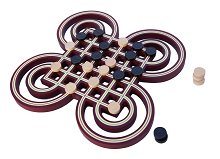The Rules of Fox & Geese
The game of Fox and Geese dates back to the middle ages and is unusual in that the sides are unequal. The sly fox attempts to capture the multitudinous geese. Meanwhile, the geese try to hem the fox in so that he can't move. At one time a popular pub game, these days Fox and Geese is less well known but it's a game that is both historical and fascinating.
See also: Fox and Geese.
Equipment
The game of Fox & Geese is played upon a cross shaped board consisting of a 3x3 point square in the middle with four 2 x 3 point areas adjacent to each face of the central square. This makes a total of 33 points. Pieces are allowed to move from one point to another only along lines which join points. Accompanying the board, there should be a single playing piece representing the fox in black or red and 15 white playing pieces representing the geese.
Preparation and Objective
Fox & Geese is a game of inequality. The geese cannot capture the fox but aim, through the benefit of numbers, to hem the fox in so that he cannot move. The objective of the fox, on the other hand, is to capture geese until it becomes impossible for them to trap him. The geese start by occupying all 6 squares of one arm of the cross plus the whole first adjacent row and the two end points of the central row. The fox starts in the middle of the board.
Basic Play
Player's toss a coin to decide who will play the fox - the geese move first. Players take turns to move a goose or the fox to an adjacent point along a line. However, the geese are restricted to being able to move directly forwards, diagonally forwards or sideways only. Upon the fox's turn, if a goose is adjacent to the fox with an empty point directly behind, the fox may capture that goose by hopping over it into the empty square and removing the smitten goose from the board. Captured pieces are never replayed onto the board and remain captured for the remainder of the game. The game is finished when a player loses either by being reduced to two pieces or by being unable to move. Like all unequal games, it makes sense to play an even number of games, each player alternating between playing the fox and playing the geese. The player who wins the most games wins the match.
Variations
The fox can start anywhere on the board not occupied by a goose at the option of the player controlling him. Variations with 13, 17 and 22 pieces can be tried. Some variations prevent the fox from moving but not capturing diagonally. The limitations on the movement of the geese can also be varied. For instance, diagonal movement can be disallowed. A huffing rule has been played in the past. If the fox can take a goose but does not do so, a new goose is added anywhere on the board by the player playing the geese.
These rules are provided by Masters Traditional Games, an Internet shop selling quality traditional games, pub games and unusual games. For general information or for copying and copyright, see our Rules Information page.
Our rules are comprehensive instructions for friendly play. If in doubt, always abide by locally-played or house rules.
Copyright James Masters, 2025. All rights reserved.


























